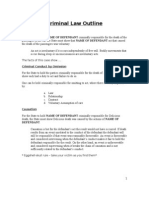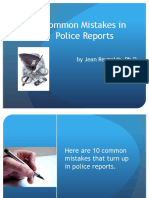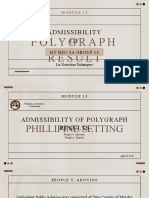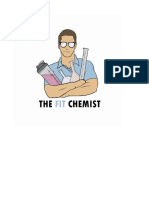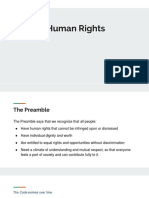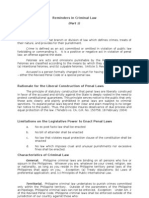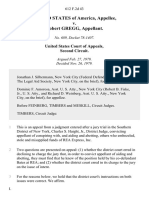Handout 2 1 1
Uploaded by
api-241505258Handout 2 1 1
Uploaded by
api-241505258HANDOUT 1: The Criminal Law
Criminal Law in Canada
Criminal law is a category of public law that punishes behaviour that results in
injury to people and/or property. In Canada, most criminal law is made by the
federal government. Some laws made by the provincial and municipal
governments are called "quasi-criminal." For example: offences under the
Motor Vehicle Act. "Quasi" is Latin for "as if". Most of the criminal laws are
found in the Criminal Code of Canada which applies to all provinces and
territories in Canada. It contains a description of crimes and criminal law
procedures.
Principles of Criminal Law
Presumption of innocence is a principle of the Canadian criminal justice system. The accused is
presumed to be innocent until proven guilty.
Burden of proof means that it is Crown counsels responsibility to prove that the accused is
guilty. The defence lawyer does not have to prove that the accused is innocent.
Beyond a reasonable doubt is the expression used when determining the likelihood that the
accused committed a crime. The Crown must prove that the accused is guilty and there cannot
be any reasonable doubt about it in the minds of the judge or jury. If there is a reasonable doubt
then the accused must be found not guilty.
Types of Crime
In the Criminal Code of Canada, three broad categories of criminal offences are used. The least
serious are summary conviction offences, the more serious are called indictable offences. An
offence that can be a summary offence or an indictable offence is known as a dual or hybrid
offence.
Summary conviction offences are punishable by no more than six months in prison or a fine.
Indictable offences allow for life sentences and larger fines. The punishment for a dual or hybrid
offence is determined by the Crowns election of whether to proceed summarily or by
indictment, with the Code prescribing available sentences. For some hybrid offences, summary
proceedings can result in penalties higher than those allowable for straight summary offences
(for example, assault causing bodily harm, upon summary conviction, is punishable by a
maximum of 18 months in jail.)
The Criminal Code of Canada has distinguished between different types of offences for three
reasons. First, some offences cause greater harm to individuals or society. Second, some
offences are considered more morally repugnant than others and third because some offences
are conducted against property while others are against people.
The Elements of a Crime
A crime occurs when an individual breaks one of our criminal laws. Every crime has two
essential parts: the physical action or actus reus and the intent or mens rea (guilty mind). For
example, the crime of arson has two parts: actually setting fire to a building and doing it wilfully
and deliberately. Setting a fire by accident may not be a crime. For most criminal cases both the
www.LawLessons.ca Section 2: Criminal Law
Justice Education Society Lesson Plan 1: Introduction to Criminal Law
actus reus and the mens rea must be proven. If either element is missing, then no crime has
been committed.
Actus reus
The physical act of committing an offence (actus reus) is more than an act, it can be an
omission to act or a state of being. For example if one is in possession of an illegal narcotic,
one is not acting or failing to act but merely in possession. This is a state of being. Omissions to
act can also be crimes (a failure to act when required to do so by law).
If a parent fails to provide the basic necessities for childrens survival the failure to provide is an
omission and a crime. The majority of crimes are acts or kinds of misconduct. Proof of the
physical element requires more than simply determining an act, omission or state of being
exists. It is necessary to consider the four Cs-conduct, consequences, circumstances and
causation. The conduct must be as described earlier an act, omission to act or a state of being
as outlined in a specific section of the criminal charge. Of particular importance to the concept of
conduct is that it be voluntary. The law will not hold someone criminally responsible for an
involuntary act. Consequences refer to the outcome of a specific act. For a homicide the
consequence would be the death of a human being.
The circumstances aspect of the actus reus refers to the relevant circumstances under which an
act must occur to be criminal. In the case of the crime of trespassing at night the relevant
circumstances would be that the act occurred at night, on someones property other than your
own and that you entered the property without consent or lawful excuse.
The final element is causation, meaning that the conduct of the accused person must be shown
to have caused the consequence (the criminal act) to occur. If Sally is charged with murdering
Bill then it must be proven that Sallys conduct caused the death of Bill.
Mens rea
The physical act represents one element in the commission of a criminal act while the guilty
mind represents the second key element. The guilty mind refers to the intention, knowledge or
recklessness of the accused. Essentially the law states that we must mean to cause a wrongful
consequence.
Intention is commonly used in the Criminal Code to establish a type of guilty mind. Words like
willfully, means to or intentionally are used to describe a state of mind. There are two basic
types of intention-specific and general. Specific intent offences frequently use the phrase with
intent or for the purpose of to demonstrate a specific purpose behind the crime. General intent
crimes are those that do not require a further purpose or intention and are often crimes
committed in moments of uncontrolled passion or aggression.
The knowledge form of a guilty mind means that the accused must have knowledge of the
specific circumstances of the crime. The phrases knowingly or knowing are commonly used
here to indicate a specific type of knowledge. For example, to knowingly lie to a judge or jury is
called perjury and is a criminal offence but to give false evidence unknowingly is not a criminal
offence.
The third kind of intent is recklessness. This is type of intent is found in crimes like dangerous
driving causing death. It means that the accused has been unduly careless in their actions by
not exercising good judgment and foresight. If one drives 100km/h through a school zone in the
www.LawLessons.ca Section 2: Criminal Law
Justice Education Society Lesson Plan 1: Introduction to Criminal Law
daytime, with no intention of killing or harming a child, and hits a child crossing the street and
that child dies, the law would use recklessness to establish the guilty mind. Contrary to TV law,
it is not necessary for the Crown to establish why an accused has committed an offence (the
motive). Motive may be used to establish intention and can be used in sentencing to mitigate or
aggravate the sentence depending on the reason for committing the crime.
Other Elements of Crime
In addition to the physical act and guilty mind the criminal law also ascribes guilt in specific
circumstances to incomplete offences and to those who are less than full participants in the
offence. A crime is considered attempted if it can be established that there was intention, that
some act toward committing the offence occurred and that the offence did not reach full
completion.
Anyone that helps, aids, or assists before, during or after the commission of an offence is a
party to that crime and can be charged under the Criminal Code as though they had actually
committed the offence. Aiding or assisting someone that you know to have committed a crime is
also a separate offence in Canada. Where people form an intention and common purpose to
carry out an unlawful act and any one of them commits a crime in carrying out the common
purpose, each person who knew that the criminal act was a likely consequence of the common
purpose is also a party to that crime. Agreeing with one or more people to commit an offence is
a conspiracy and is a crime in Canada. Therefore if you plan to commit a crime, even if you do
not complete the act, it is a crime. Counselling others to commit an offence is also unlawful.
Criminal Case Studies
Look at the case studies below and answer the questions posed with respect to the key criminal
elements covered above (e.g. mens rea, actus reus, party to an offence).
Criminal Case Studies
Case 1
Marion asked Sarah to take care of her infant boy for a few days. Marion also asked Sarah to
give the infant a teaspoonful of medicine every night. In fact, the medicine was poison. Sarah
did not think that the infant needed medicine so she did not give it to him. She put the medicine
on a shelf in her living room. Later, Sarahs five-year-old son gave the infant a large dose of the
medicine and the infant died. Marion was charged with murder.
Is Sarah or Marion guilty of murder? Explain.
____________________________________________________________________________
____________________________________________________________________________
____________________________________________________________________________
____________________________________________________________________________
____________________________________________________________________________
____________________________________________________________________________
www.LawLessons.ca Section 2: Criminal Law
Justice Education Society Lesson Plan 1: Introduction to Criminal Law
Case 2
Eva, Donna, and Claudia are walking through the park when they see their enemy Jim walking
with a friend. They decide to have some fun. So Donna and Claudia hold back Jims friend
while Eva punches and kicks him. Donna and Claudia laugh and yell their support to Eva.
Meanwhile Mike, who is walking his dog, stops for a moment to see what is going on. Mike
decides not to get involved and walks on. Eva is convicted of assault causing bodily harm.
Should Donna or Claudia be charged with an offence? Explain.
____________________________________________________________________________
____________________________________________________________________________
____________________________________________________________________________
____________________________________________________________________________
____________________________________________________________________________
What about Mike? Explain.
____________________________________________________________________________
____________________________________________________________________________
____________________________________________________________________________
____________________________________________________________________________
____________________________________________________________________________
Case 3
Murray, Josie (Murrays wife) and Rosa agree to steal some money from Petes clothing store.
They also agree that Pete will not be harmed and that no weapons will be used. Murray enters
the store and gets Petes attention by asking him questions about an article of clothing. Then
Josie enters the store and walks toward the cash register while Rosa acts as a look-out near the
store entrance. Pete notices Josie reaching into the drawer of the cash register and yells loudly.
Rosa panics, pulls a gun, and shoots Pete, severely wounding him. Murray, Josie, and Rosa run
from the store and go to Russs apartment around the corner. Russ agrees to let them use his
car and Murray, Josie, and Rosa drive to a hiding place. Pete later dies from the wound he
received.
Explain the criminal acts of Murray, Josie, Rosa, and Russ.
____________________________________________________________________________
____________________________________________________________________________
____________________________________________________________________________
____________________________________________________________________________
____________________________________________________________________________
____________________________________________________________________________
www.LawLessons.ca Section 2: Criminal Law
Justice Education Society Lesson Plan 1: Introduction to Criminal Law
You might also like
- Havea Circle Shooting Search Warrant UnsealedNo ratings yetHavea Circle Shooting Search Warrant Unsealed9 pages
- Basic Criminal Investigation For Police RecruitsNo ratings yetBasic Criminal Investigation For Police Recruits136 pages
- Compilations in Criminal Investigation 09No ratings yetCompilations in Criminal Investigation 09168 pages
- ULTRA SHREDDED Nutrition Plan by GM NutritionNo ratings yetULTRA SHREDDED Nutrition Plan by GM Nutrition2 pages
- Common Mistakes in Police Reports: by Jean Reynolds, PH.DNo ratings yetCommon Mistakes in Police Reports: by Jean Reynolds, PH.D33 pages
- Personalized Meal Plans Instruction GuideNo ratings yetPersonalized Meal Plans Instruction Guide3 pages
- (Notes) Week 9 Investigative Interviewing AY 1920No ratings yet(Notes) Week 9 Investigative Interviewing AY 192034 pages
- Optimum Fat Loss Meal Plan - 2000 CaloriesNo ratings yetOptimum Fat Loss Meal Plan - 2000 Calories2 pages
- Interrogation Technique Manual 1. Positive ConfrontationNo ratings yetInterrogation Technique Manual 1. Positive Confrontation1 page
- LEA 4 - Police Intelligence Notes Md. 5No ratings yetLEA 4 - Police Intelligence Notes Md. 5146 pages
- Mentally Recreate Context of Accident Report Everything Recall in Different Order Recall From Changed PerspectiveNo ratings yetMentally Recreate Context of Accident Report Everything Recall in Different Order Recall From Changed Perspective1 page
- 2300 CALORIE Meal Plan: Author: Holly Louise #Thefitpharmacist @thefitpharmacist - @bodyscience ExpertNo ratings yet2300 CALORIE Meal Plan: Author: Holly Louise #Thefitpharmacist @thefitpharmacist - @bodyscience Expert17 pages
- Test Yourself: Quoting Suspects, Victims, and Witnesses100% (1)Test Yourself: Quoting Suspects, Victims, and Witnesses1 page
- The Fit Chemist Calorie Tracking SpreadsheetNo ratings yetThe Fit Chemist Calorie Tracking Spreadsheet32 pages
- An8hyeyzxpkjyeu2ixuvhf1 3mkkiau8a4omghsfflm6f Jax1doteo B9gcqyai1iraijrxorwh5lv9exb2h1yihab Yjbkly7q1pqtayr48se9pxqufiozaqjh3gNo ratings yetAn8hyeyzxpkjyeu2ixuvhf1 3mkkiau8a4omghsfflm6f Jax1doteo B9gcqyai1iraijrxorwh5lv9exb2h1yihab Yjbkly7q1pqtayr48se9pxqufiozaqjh3g29 pages
- Technical English 1 Investigative Report Writing and PresentationNo ratings yetTechnical English 1 Investigative Report Writing and Presentation132 pages
- Aamir+Khanâ s+Fat+Loss+Diet+for+Dhoom+3 PDFNo ratings yetAamir+Khanâ s+Fat+Loss+Diet+for+Dhoom+3 PDF4 pages
- By DR John Berardi, CSCS: The Get Shredded Diet0% (1)By DR John Berardi, CSCS: The Get Shredded Diet17 pages
- Fids Presentation Worksheet Charter Cases 2017No ratings yetFids Presentation Worksheet Charter Cases 20174 pages
- Termination: Filing An Employment Standards ClaimNo ratings yetTermination: Filing An Employment Standards Claim12 pages
- Clu3m Ontario Human Rights Code 2016 PPTX 1100% (1)Clu3m Ontario Human Rights Code 2016 PPTX 131 pages
- United States v. Gerald Olgin, Marilyn Olgin, Jerome Shapiro, James F. O'brocta. Appeal of James F. O'BrOcta, 745 F.2d 263, 3rd Cir. (1984)No ratings yetUnited States v. Gerald Olgin, Marilyn Olgin, Jerome Shapiro, James F. O'brocta. Appeal of James F. O'BrOcta, 745 F.2d 263, 3rd Cir. (1984)21 pages
- Criminal Law Transcript For Judge Pimentel Part 2100% (1)Criminal Law Transcript For Judge Pimentel Part 265 pages
- Morigo Vs People - 145226 - February 6, 2004 - JNo ratings yetMorigo Vs People - 145226 - February 6, 2004 - J7 pages
- Volunteer Manual Catholic Community Services of Western WashingtonNo ratings yetVolunteer Manual Catholic Community Services of Western Washington42 pages
- Stan J Caterbone OPEN Federal Cases in US DISTRICT COURT Eastern PA July 10, 2015No ratings yetStan J Caterbone OPEN Federal Cases in US DISTRICT COURT Eastern PA July 10, 2015119 pages
- S v Nonkasu Onus and Splitting of ChargesNo ratings yetS v Nonkasu Onus and Splitting of Charges4 pages
- United States v. Robert Gregg, 612 F.2d 43, 2d Cir. (1979)No ratings yetUnited States v. Robert Gregg, 612 F.2d 43, 2d Cir. (1979)11 pages
- PEOPLE OF THE PHILIPPINES, Plaintiff-Appellee, vs. GILBERT Elijorde Y de La Cruz and Reynaldo Punzalan Y ZACARIAS Alias KIRAT, Accused-AppellantsNo ratings yetPEOPLE OF THE PHILIPPINES, Plaintiff-Appellee, vs. GILBERT Elijorde Y de La Cruz and Reynaldo Punzalan Y ZACARIAS Alias KIRAT, Accused-Appellants8 pages
- Krebs, Joint Criminal Enterprise in English and German Law PDFNo ratings yetKrebs, Joint Criminal Enterprise in English and German Law PDF337 pages
- United States v. Ronald Barlin, Herbert Frank, Anthony Cuccio, Bruce Erbacher, George Gleckler, Pauline Frank, Milagros Fantauzzi and John Doe, A/K/A "Pepe", Milagros Fantauzzi, Ronald Barlin, Herbert Frank, Anthony Cuccio and George Gleckler, 686 F.2d 81, 2d Cir. (1982)No ratings yetUnited States v. Ronald Barlin, Herbert Frank, Anthony Cuccio, Bruce Erbacher, George Gleckler, Pauline Frank, Milagros Fantauzzi and John Doe, A/K/A "Pepe", Milagros Fantauzzi, Ronald Barlin, Herbert Frank, Anthony Cuccio and George Gleckler, 686 F.2d 81, 2d Cir. (1982)16 pages
- Chapter 2 Some Important Basic ConceptsNo ratings yetChapter 2 Some Important Basic Concepts16 pages






